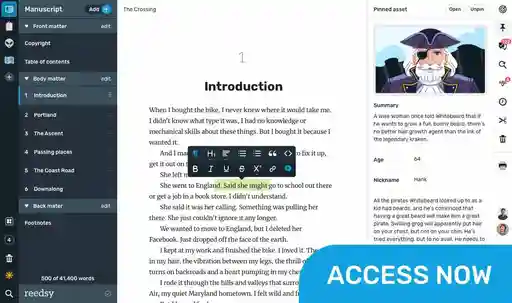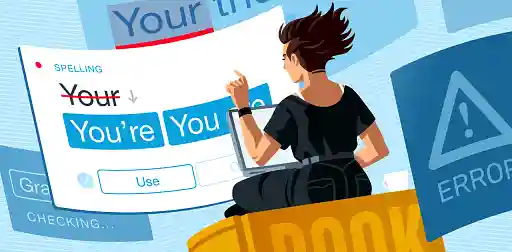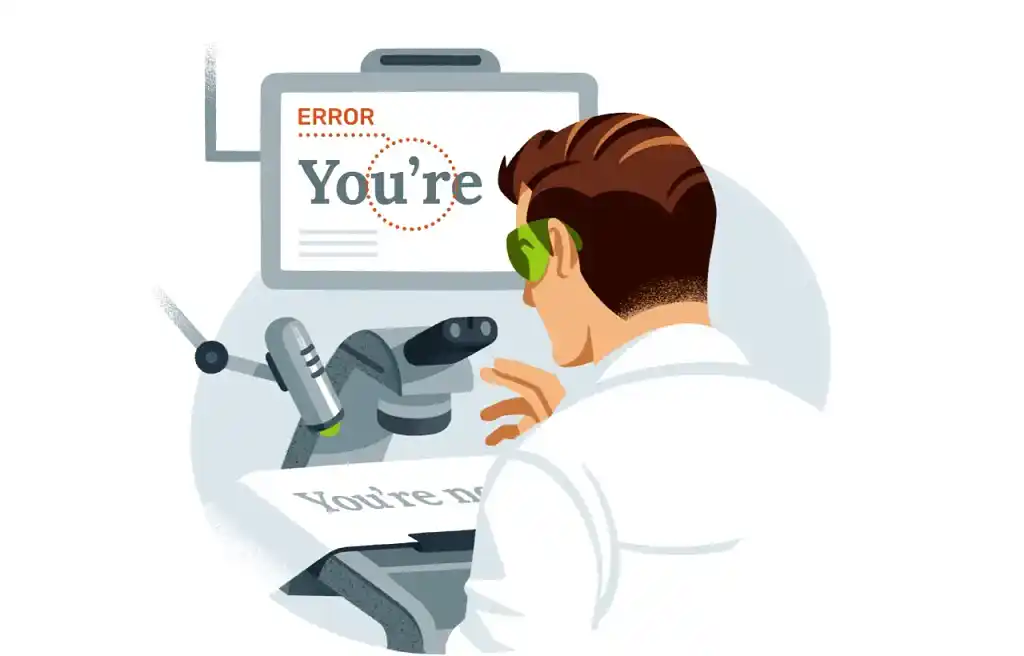Last updated on Oct 14, 2025
How to Use Semicolons: Rules and Examples
Linnea Gradin
The editor-in-chief of the Reedsy Freelancer blog, Linnea is a writer and marketer with a degree from the University of Cambridge. Her focus is to provide aspiring editors and book designers with the resources to further their careers.
View profile →A semicolon ( ; ) is a type of punctuation used to join two closely related independent clauses — aka standalone sentences — without relying on a coordinating conjunction (like “and”, “or”, “but”). It can also be used to separate items in a complex list (where commas alone could look messy) and link clauses with conjunctive adverbs, like “however” or “in conclusion”.
A semicolon pauses longer than a comma, but stops short of a period, making it a highly versatile tool for writers. Despite its usefulness, however, the semicolon gives many people pause (no pun intended!).
According to a 2025 Babbel study, semicolons are falling out of fashion — in British English books, their frequency has dropped from once every 205 words in 2000 to once every 390 today. A survey of over 500,000 British students also showed that two-thirds rarely or never use semicolons, only 11% called themselves “frequent users”, and more than half struggled to use it correctly.
So if you hesitate before using this punctuation, you’re not alone. But in truth, semicolons aren’t that complicated. They follow a few clear rules that this guide will break down — complete with examples. After reading, you’ll know when to reach for this punctuation mark and when to leave it out!
Semicolons vs. colons: what’s the difference?
Semicolons (;) and colons (:) may look similar, but they serve distinct purposes in writing. Knowing when to use each is a key skill — whether you’re polishing academic work or aiming for professional writing.
The colon (:)
A colon is used to introduce or emphasize what follows. You’ll often see it:
-
Before a list or explanation.
→ The hero’s success depended on three things: courage, skill, and luck.
-
In dialogue formatting.
→ Reporter: What inspired your journey?
-
In titles and subtitles.
→ The Hero’s Journey: An Age-Old Battle Against Evil.

A colon essentially bridges two closely related parts of a sentence, where the second completes the first — that is, one part doesn’t make sense without the other.
Note that if the first word after the colon is a title or start of a full sentence (as in the dialogue example), then it should be capitalized. Otherwise, the word after the colon can remain lowercase (as in the list example).

FREE COURSE
How to Write Believable Dialogue
Master the art of dialogue in 10 five-minute lessons.
The semicolon (;)
Meanwhile, the semicolon is part period, part comma. Use it to:
-
Link related independent clauses.
→ I crave sunshine; I also crave gelato.
-
Replace coordinating conjunctions.
→ I finished my homework; my sister didn’t.
-
Separate complex lists.
→ Paris, France; Rome, Italy; and Barcelona, Spain.
-
Connect clauses with transitional phrases.
→ She’s beautiful; more importantly, she’s brilliant.
There are four fundamentals that explain when to use semicolons, and we’ll explore each one below. And for even more examples of semicolons vs. colons vs. commas as well, you can jump to the table at the end of this post
Semicolons can…
1. Link independent clauses
One of the main jobs of a semicolon is to connect two independent clauses — sentences that could stand on their own, but have some kind of relationship. In other words, semicolons connect independent yet interdependent ideas!
What exactly is an independent clause?
An independent clause is a complete sentence with a subject and a verb, and it expresses a full thought/action. It can be short (“I smiled”) or longer (“I smiled at the woman across the street”), but it must be grammatically capable of standing alone.
A dependent clause, by contrast, can’t stand alone. Add a word like “when” — as in “When I smiled” — and suddenly you’ve got a dependent clause: an incomplete thought that’s merely a sentence fragment on its own.
In short, you can link two independent clauses using a semicolon, but dependent clauses will need a different connector.

More examples of semicolons linking independent clauses
I smiled; I was happy to see her.
Maria loves the beach; she craves sun, sand, and surf.
The man was confused; he had never seen a robot dog before.
Not all who wander are lost; some just want to see where life takes them.
In all of these cases, each clause (on either side of the semicolon) is a complete sentence. However, they’re all still related to each other. In every example here, the second sentence makes sense on its own while also building on the first one. This is how semicolons can connect ideas, or add explanation or evidence without breaking the narrative flow.
Pro tip: Another easy way to identify independent clauses (and whether they could be linked by a semicolon) is to test whether they make sense with a period. Consider the following:
“I smiled. I was happy to see her.”
This makes grammatical sense! So you can go ahead and put a semicolon between these independent clauses if you want to.
2. Replace coordinating conjunctions
Semicolons can also be effective replacements for coordinating conjunctions — the “glue” words that link independent clauses. These conjunctions like and, but, or, so, yet, for, and nor usually signal causality, contrast, or relation between ideas.
But if the context already makes the connection obvious, you can safely drop the conjunction and use a semicolon instead. Take a look at the example below to see how this works.
With conjunction: I saw your sister in town yesterday, but she didn’t notice me.
With semicolon: I saw your sister in town yesterday; she didn’t notice me.
Here, the contrast between “seeing” and “not being noticed” is already clear, so the semicolon smoothly replaces but. This kind of semicolon usage is especially common in factual works like academic essays and nonfiction books — these works usually prioritize clarity, so they can use semicolons without confusing readers.
Pro tip: Remember that you cannot use both a semicolon and a conjunction in the same spot. “I saw your sister in town yesterday; but she didn’t notice me” would be incorrect.
Or let the reader fill in the blanks
All that said, the exception to the “total clarity” rule is if you’re being intentionally ambiguous for creative reasons. In this context, a semicolon strategically placed between two independent clauses can invite interpretation.
For example:
Spring came early this year; tears kept filling my eyes.
Does the narrator feel sadness because of spring, despite it, or for some other reason entirely? Maybe spring triggers painful memories and grief — or maybe it’s just allergies! By replacing a conjunction with a semicolon here, the writer lets the reader decide how these phrases relate.

3. Separate complex lists
Once again, you wouldn’t normally pair a semicolon with a coordinating conjunction like “and” or “but”. The exception is when it improves readability — especially in long, complex lists that would otherwise be full of commas.
Example of a list with semicolons
I had several things to do before Maya’s party, the most important of which were picking up the cake at the bakery; blowing up the balloons and arranging them around the house; and wrapping her presents, including a fancy new set of long-stemmed wine glasses.
Notice the final “and” before “wrapping her presents”? Here, it’s clarifying the list, rather than linking the clauses — so we do need the coordinating conjunction. Relatedly, using colons wouldn’t work here, since the semicolons are only demarcating entities and making the sentence easier for readers to scan.
Semicolons can also help when linking independent clauses that are already packed with commas:
My brother is very clumsy. He often stumbles over roots, breaks things, and won’t look where he’s going; nor will he consider other people’s feelings when he speaks.
Here, the semicolon + conjunction (“nor”) keeps the sentence clear.
4. Combine with conjunctive adverbs
Lastly, semicolons can also step in when you want to connect two independent clauses with a conjunctive adverb (aka a transitional phrase). These words — like however, moreover, or therefore — guide readers through your reasoning and are especially commonplace in essays, arguments, or rhetorical writing.
Here’s how it works:
|
Conjunctive adverb / transitional phrase |
Sample sentence |
|
Moreover |
The hike was exhausting; moreover, the sudden rain made it even harder. |
|
However |
Grace went to the grocery store; however, she came back empty-handed. |
|
Nevertheless |
Katy always had the best of intentions; nevertheless, she often ended up causing drama. |
|
Also |
I love reading; also, I love watching Netflix. |
|
Consequently |
He was a careful planner; consequently, he had a solution for every situation. |
|
Likewise |
Tony was very superstitious; likewise, Maria always crossed the street when she saw a black cat. |
|
By contrast |
Paul dreamed of becoming a surgeon; by contrast, Sara dreamed of owning a sandwich shop. |
|
In addition |
For Christmas, Billy wished for a new toy car; in addition, he wanted the latest Avengers action figures. |
|
In fact |
I never believed in fairy tales; in fact, I always thought they were nonsense. |
|
As a result |
Max liked to gamble; as a result, he lost all his savings. |
Pro tip: Don’t use a comma between two independent clauses joined by a conjunctive adverb — that’s a comma splice:
❌ Max liked to gamble, as a result, he lost all his savings.
Using a semicolon instead keeps the ideas closely linked, without the choppiness of a full stop. If you’re unsure about catching these minute details yourself, a professional proofreader can help polish your writing!

Perfect your writing with a professional edit
The best copy editors, and proofreaders are on Reedsy. Sign up for free and meet them.
Learn how Reedsy can help you craft a beautiful book.
Use semicolons when needed, not to look smart
Now that you know the main rules for semicolons, here’s the golden one: just because you can use a semicolon, doesn’t mean you should. Semicolons are a tool for clarity, not decoration. They shine in academic writing and nonfiction — pieces in which authors often need to connect independent clauses or insert conjunctive adverbs without creating run-on sentences.
That said, semicolons also have a reputation for making text feel cluttered. Particularly in creative writing, overusing them can come across as self-conscious or heavy-handed. If a simple period or em dash (notorious in 2025, we know!) communicates the same idea with more elegance, go for that instead.
Remember, the purpose of punctuation is readability and rhythm — but which one you prioritize might depend on context. Compare these to get a better idea:
|
With semicolons |
Without semicolons |
|
Hye-jin is a big foodie. She loves the comforting, spicy, sweet, umami flavors of her favorite Korean dishes from home; elegant, though hard to master, classic French cuisine; and, more than anything, creative and experimental fusion food at restaurants that combine the best of both worlds. |
Hye-jin is a big foodie. She loves the comforting Korean dishes from home, with their spicy, sweet, umami flavors. At the same time, she enjoys elegant, classic French cuisine, even though it’s hard to master. But more than anything, she loves the creative, experimental fusion food at restaurants that combine the best of both worlds. |
Both of these options are technically correct. The first version might work well in a more “poetic” piece about culture and cuisine, with many consecutive phrases and semicolons creating a sort of artistic flow to the passage. The second example, on the other hand, scans as “simpler” phrasing — but perhaps reads more clearly as a result. There’s no definitive “right” version; it just depends on what effect you’re going for!
Check out the table below to know exactly which punctuation can come to your aid when you’re writing or revising a draft.
More examples: Colon vs. semicolon vs. comma
|
Punctuation mark |
Purpose |
Examples |
|
Colon (:) |
A colon introduces or emphasizes a list, explanation, or definition. A colon can also connect the title and subtitle of a book, article, or similar. |
She had one goal: to finish the marathon. Trick Mirror: Reflections on Self-Delusion by Jia Tolentino |
|
Semicolon (;) |
A semicolon links two independent but related clauses; separates items in complex lists; pairs with conjunctive adverbs. |
I have a test tomorrow; however, I still went out. I’m visiting London, England; Berlin, Germany; and Athens, Greece. |
|
Comma (,) |
A comma separates items in a simple list or sets off dependent clauses. Commas are mostly used with conjunctions. |
I bought apples, oranges, and bananas. When I am happy, I smile. |
It’s easy to get bogged down in grammar and forget that most writing is meant to clearly convey what you are saying. Sometimes, the semicolon can help you achieve that; when it doesn’t, you might need to look at the sentence from a new angle. Happy writing!







